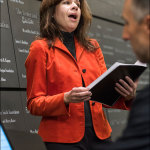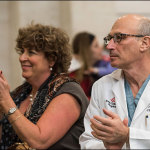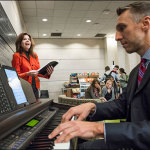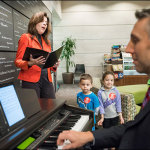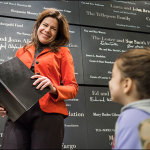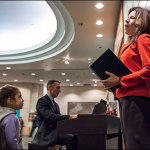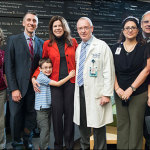Texas Children’s Medical Staff: Required Training for Fluroscopic Procedures
On May 1, 2013 the Texas Department of State Health Services (DSHS) made specific changes to its regulations of Texas Administrative Code §289.227 “Use of Radiation Machines in the Healing Arts.” This rule requires all physicians and midlevel providers to obtain additional radiation training prior to performing fluoroscopic procedures. This is not a Texas Children’s Hospital policy but a modification of state law goes into effect May 1, 2015. Read more
12/18/2014
Mata conjoined twins take first step toward separation with tissue expansion
Conjoined 8-month-old twin girls, Knatalye Hope and Adeline Faith Mata, underwent a five-hour surgery December 16 at Texas Children’s Hospital Main Campus to place custom-made tissue expanders into their chest and abdomen area. The tissue expanders will help stretch the babies’ skin in preparation for their separation surgery, which is expected to take place early next year. Dr. Alberto Hernandez with Interventional Radiology performed the examination. Chief of Plastic Surgery Dr. Larry Hollier and Dr. Ed Buchanan with the Division of Plastic and Reconstructive Surgery conducted the tissue expander placement surgery. Dr. Helana Karlberg led the anesthesia team and Audra Rushing led the surgical nursing team. Read more
12/18/2014
Tessier receives NASPGHAN Fellow Research Award for C. Difficile study
Dr. M. Elizabeth Tessier, a pediatric gastroenterology fellow at Texas Children’s, received the 2014 Fellow Research Award from the North American Society for Pediatric Gastroenterology, Hepatology and Nutrition (NASPGHAN). Her award-winning study titled, “Bile acid signatures in children confer protection from clostridium difficile infection,” found that changes in the bile acid composition in the stool may predispose patients to Clostridium difficile (C.diff), a bacterial infection that causes intestinal inflammation and diarrhea. Read more
12/17/2014
Neurosurgery represents Texas Children’s at AANS Annual Meeting
The Texas Children’s Hospital Division of Neurosurgery was well represented at the recent American Association of Neurological Surgeons annual meeting in Amelia Island, Fla. The division had eight posters accepted for presentation. Of those eight, three were selected as “Top Posters.” In addition, Neurosurgery had four abstracts accepted for oral presentation. Read more
12/16/2014
Voice of Nursing blog: Physician-nurse partnership (By Dr. Tony Mott)
Trust, respect and a sense of humor. What do these things have in common? In my opinion, they’re the key ingredients for developing a successful nurse-physician partnership. As medical director, my partnership with Assistant Clinical Director Tarra Kerr is vital to the success of 15 West Tower. In fact, from our shared partnership, we have established a shared vision – a vision of what 15WT can be and the path to that end. Read more
12/16/2014
Department of Surgery unveils surgery preparation video
No parent ever wants to hear their child will need to have surgery – whether it’s a routine procedure that only takes minutes or it’s something more serious. That’s why the Department of Surgery goes out of its way to make the surgical experience at Texas Children’s a good one for patients as well as their families. The department’s most recent effort to ensure a positive surgical experience is had by all is a video for parents that talks about what to expect when their child has surgery at Texas Children’s. The video, available in English and Spanish, covers eating and drinking instructions, what to bring to the hospital and what parents will experience while their child is in surgery. “Our goal in the Department of Surgery is to have our patients and their families prepared as well as possible for the surgical experience,” Chief of Plastic Surgery Dr. Larry Hollier said. “Setting appropriate expectations is crucial to patient satisfaction.” Read more or Watch video
12/16/2014
The patient census and what it means for Texas Children’s
On any given day, hundreds of patients come through the hospital doors at Main Campus and West Campus. Whether they walk through our doors on their own, or are transferred from another hospital, these patients require the care of Texas Children’s Hospital specialists. In November, 101 patients had to be turned away from Texas Children’s Hospital. The patients were denied a transfer from another institution because we were above census. “We have to always remember that when people come to us, they are bringing their children who are ill for care,” said Surgeon-in-Chief Dr. Charles D. Fraser, Jr. “We have to put ourselves in their position, and respond.” Read more or Watch video
12/16/20146
Texas Children’s hosts second cardiac artery anomalies conference
Texas Children’s Hospital hosted its second national conference December 4 and 5, addressing a series of fatal conditions known as coronary artery anomalies. Coronary artery anomalies are a group of rare congenital heart defects that have been associated with coronary ischemia, myocardial infarction, and sudden death. It is the second most common cause of sudden death in young healthy athletes. Read more
12/16/20146
Texas Children’s Heart Transplant Program celebrates 30th anniversary
Texas Children’s Hospital recently celebrated the 30th anniversary of its heart transplant program. Since its inception in 1984, Texas Children’s Heart Center has performed more than 300 heart transplants, making the program one of the most active and largest in the nation. “The true results of our team’s exceptional work over the past 30 years can be seen in the hundreds of success stories of our patient families,” said Texas Children’s Heart Failure, Cardiomyopathy and Cardiac Transplantation Medical Director Dr. Jeff Dreyer. “As one of the largest programs in the nation, our experience in treating patients with heart failure is leading the way in positive outcomes.” Read more
12/09/2014
Kayyal to co-lead development of Neuro-NICU program
Dr. Simon Kayyal, an assistant professor of pediatrics and neurology at Baylor College of Medicine, recently joined Texas Children’s neurology team. He will develop and co-lead the Neuro-Neonatal Intensive Care Unit (Neuro-NICU) with Texas Children’s Neonatologist Dr. Jeffrey R. Kaiser, a professor of pediatrics, obstetrics and gynecology at Baylor College of Medicine. Read more
12/08/2014
Hand and Microvascular Surgery Clinic offers multidisciplinary team
Patients treated at the Texas Children’s Hospital Hand and Microvascular Surgery Clinic now benefit from not only two physicians whose focus is on hand and upper extremity care but also from a full-time certified hand therapist. Plastic and reconstructive surgeons Dr. Mitchel Seruya and Dr. Thomas Hunt III formed a multidisciplinary team with certified hand therapist Tara Haas. Seruya, Hunt and Haas work with registered nurses, occupational hand therapists and medical assistants to perform clinical evaluations, formulate diagnoses and provide treatment plans for patients. Read more
12/03/2014
Texas Children’s Pediatrics opens new practice, merges two others
Texas Children’s Pediatrics recently welcomed a new practice to the inner loop and merged two others in the Houston area. The new practice, Texas Children’s Pediatrics Green Park, opened November 18 and is located at 7505 S. Main St., Suite 450. Three new physicians – Dr. Michael Connelly, Dr. Shannon Hayes and Dr. Jackie Wanebo – are seeing patients at the location. Connelly, a Houston native, earned his medical degree from and completed his residency with the University of Texas Medical School in Houston. Connelly specializes in fitness, healthy eating, and infants and newborns. Hayes is from Katy and earned her medical degree from Baylor College of Medicine. Hayes completed her residency at Baylor as well, and trained at Texas Children’s Hospital. Wanebo came to Texas from Charlottesville, Va., earned her medical degree from the University of Virginia and completed her residency with the University of North Carolina Chapel Hill. She specializes in asthma, healthy eating, teenagers and children with special needs. Read more
Submissions for Bench and Bedside
Bench and Bedside will be produced monthly to spotlight recent news about Texas Children’s physicians and scientists. The Connect team welcomes submissions related to speaking engagements, staff awards/recognition, research, clinical work and academic activities. Send your questions or submissions to connectnews@texaschildrens.org.






